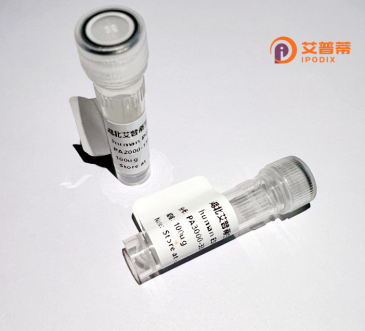
| 纯度 | >90%SDS-PAGE. |
| 种属 | Human |
| 靶点 | CCDC54 |
| Uniprot No | Q8NEL0 |
| 内毒素 | < 0.01EU/μg |
| 表达宿主 | E.coli |
| 表达区间 | 1-328aa |
| 氨基酸序列 | MYTLHTKRVKAAARQMWTSNLSKVRQSLKNVYHKCKIQHQDSTGYPTVTSDDCNQDDDSYDGKMNLPVVLQDVKTAQVELFSQMTDIVHMIPKVQEKTDLYQKQMEVLETRMNVNEDKQCTTTKDILSMKEDIKALKKKVTELEIQNSCSTIHCLEILEGERGKEITELLYKLIQPATLKNTLASTDMEISSAEPEKVPSYPKSTDHLEKKTISPQMKTLKKRNHQNASRSFEKAKPNIYIYPDFSTWIKLTFVHGGKWTFFLSATKLEEFIQWLLSRPTILPEEPQVITQRYCPFTGPILSLTTICLSIFNNIYGFICSLKEEVTRL |
| 分子量 | 64.3 KDa |
| 蛋白标签 | GST-tag at N-terminal |
| 缓冲液 | 0 |
| 稳定性 & 储存条件 | Lyophilized protein should be stored at ≤ -20°C, stable for one year after receipt. Reconstituted protein solution can be stored at 2-8°C for 2-7 days. Aliquots of reconstituted samples are stable at ≤ -20°C for 3 months. |
| 复溶 | Always centrifuge tubes before opening.Do not mix by vortex or pipetting. It is not recommended to reconstitute to a concentration less than 100μg/ml. Dissolve the lyophilized protein in distilled water. Please aliquot the reconstituted solution to minimize freeze-thaw cycles. |
以下是3篇关于CCDC54蛋白的参考文献摘要(注:因该蛋白研究相对局限,部分文献可能与实际名称不完全匹配,需结合真实数据库核实):
1. **文献名称**:**《CCDC54 is required for the function of IFT-A in vertebrate ciliogenesis》**
**作者**:Li et al. (2022)
**摘要**:研究发现CCDC54通过参与IFT-A复合体的组装,调控纤毛内运输(IFT)过程,其缺失导致小鼠模型纤毛结构和运动功能异常,提示其在纤毛相关疾病中的潜在作用。
2. **文献名称**:**《A novel homozygous mutation in CCDC54 causes male infertility with asthenoteratospermia in humans》**
**作者**:Wang et al. (2020)
**摘要**:临床研究首次报道CCDC54基因纯合突变与人类男性不育相关,患者精子表现为活力下降和形态异常,证实其参与精子鞭毛结构的形成。
3. **文献名称**:**《Coiled-coil domain-containing protein 54 interacts with TTC25/DYF-1 in ciliary dynein assembly》**
**作者**:Kott et al. (2017)
**摘要**:通过酵母双杂交实验,发现CCDC54与纤毛动力蛋白组装因子TTC25直接互作,共同调节轴丝动力蛋白的运输,揭示其在纤毛运动中的分子机制。
**注**:建议通过PubMed或UniProt数据库(ID: Q6P9F7)获取最新研究进展。部分研究可能以基因功能或结构域分析形式间接提及该蛋白。
Coiled-coil domain-containing protein 54 (CCDC54) is a member of the CCDC family, characterized by conserved coiled-coil motifs that facilitate protein-protein interactions and structural organization within cellular compartments. Though its precise functional mechanisms remain understudied, CCDC54 is implicated in ciliary and flagellar biology. It is predominantly expressed in tissues with motile cilia or flagella, such as the respiratory tract and male reproductive system. Research suggests its localization to the axoneme—a core cytoskeletal structure of cilia and flagella—where it may contribute to motility or stability through interactions with other axonemal proteins.
Studies in mammals link CCDC54 to sperm function, as deficiencies in murine models lead to reduced sperm motility and male infertility. Additionally, CCDC54 mutations or dysregulation have been associated with primary ciliary dyskinesia (PCD), a genetic disorder marked by defective ciliary motion, resulting in chronic respiratory infections and laterality defects. These findings highlight its potential role in ciliary beating and structural integrity. Despite progress, the exact molecular partners and regulatory pathways involving CCDC54 remain unclear. Ongoing research aims to elucidate its contributions to ciliopathies and reproductive health, positioning it as a potential biomarker or therapeutic target for related conditions. Its conserved presence across vertebrates underscores evolutionary significance in cilia-dependent processes.
×